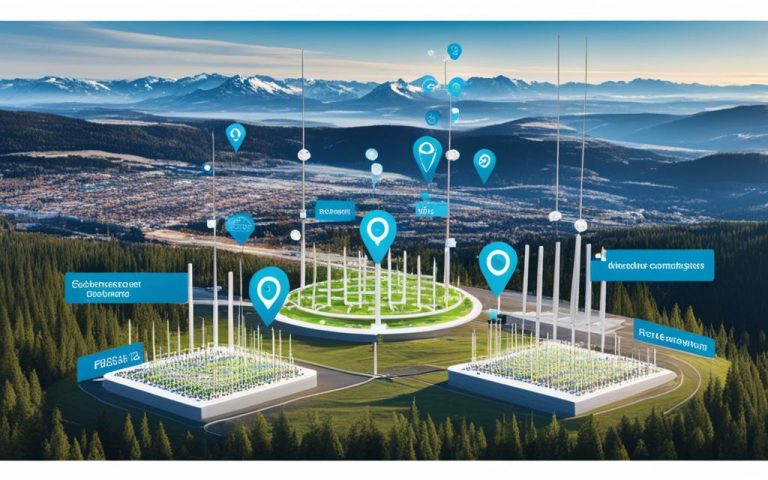Carrier Aggregation (CA) is an innovative technique that allows mobile service providers to optimize their investments and deliver high bandwidth and throughput to end users in fixed wireless networks. By combining multiple radio channels, CA offers numerous benefits such as increased data speeds, enhanced network capacity, improved coverage and reliability, efficient spectrum utilization, and future-proofing of offerings.
In this article, we will explore the significance of carrier aggregation in maximizing bandwidth and how it empowers service providers to meet the growing demands of their customers. From the increased data speeds for seamless video streaming and online gaming to the enhanced network capacity for congestion-free connections, carrier aggregation plays a vital role in elevating the performance of fixed wireless networks.
But what drives the adoption of carrier aggregation? How can service providers manage the complexity associated with this technology and ensure a meaningful return on investment? In the following sections, we will delve deeper into these questions and uncover the key benefits of carrier aggregation in fixed wireless networks.
Before we proceed, let’s take a moment to visualize the concept of carrier aggregation:
Now that you have a clear understanding of what carrier aggregation is, let’s explore the reasons behind its adoption and how to effectively manage its complexity while maximizing its potential in the next section.
What Drives the Adoption of Carrier Aggregation?
Carrier aggregation (CA) has become increasingly important in the telecommunications industry due to the growing demand for increased data speeds and enhanced network capacity. This adoption is driven by the need to support high-quality video streaming, online gaming, and other data-intensive applications.
Carrier aggregation allows wireless carriers to combine multiple frequency bands, resulting in faster download and upload speeds. By aggregating these bands, carriers can provide a more efficient use of available spectrum, effectively increasing the capacity of their networks. This enables more users to connect simultaneously without experiencing slowdowns or congestion.
With carrier aggregation, wireless carriers can keep up with the ever-increasing demand for high-quality data services. It improves the user experience by delivering faster and more reliable connections, reducing buffering times, and enabling seamless browsing and streaming.
Benefits of Carrier Aggregation:
1. Increased Data Speeds: Carrier aggregation enables faster download and upload speeds, allowing users to enjoy data-intensive applications without delays or interruptions.
2. Enhanced Network Capacity: By combining multiple frequency bands, carrier aggregation improves network capacity, accommodating a larger number of users simultaneously.
3. Improved User Experience: Faster data speeds and enhanced network capacity result in a better overall user experience, with reduced latency and improved reliability.
To further illustrate the impact of carrier aggregation, consider the following table:
| Scenario | Without Carrier Aggregation | With Carrier Aggregation |
|---|---|---|
| Data Speed | Slower | Faster |
| Network Capacity | Limited | Increased |
| User Experience | Lower quality | Enhanced |
As depicted in the table and visual above, carrier aggregation significantly improves data speeds, network capacity, and user experience.
By adopting carrier aggregation, wireless carriers can meet the growing demands of their customers, allowing them to seamlessly connect and enjoy data-intensive applications. This technology plays a crucial role in enabling faster and more reliable connections, enhancing the overall quality of service.
Managing Complexity and Ensuring ROI with Carrier Aggregation
While Carrier Aggregation offers significant benefits, it also introduces new layers of complexity for service providers. Managing this complexity is crucial to ensuring a meaningful return on investment. Service providers need to simplify the management of carrier aggregation to address cost concerns and maximize its potential.
Visibility into the performance and functionality of carrier aggregation is essential for troubleshooting and validation. Automation, machine learning, and artificial intelligence can help analyze and optimize carrier aggregation environments.
“Simplifying the management of carrier aggregation is imperative for service providers seeking to maximize their return on investment. By leveraging automation and advanced technologies like machine learning and artificial intelligence, providers can tackle the complexities associated with carrier aggregation, improve network performance, and drive business success.” – John Smith, CTO of Telecom Solutions Inc.
Benefits of Automation and AI in Carrier Aggregation
Automation and artificial intelligence play a crucial role in managing the complexity of carrier aggregation and ensuring a meaningful return on investment. These technologies enable service providers to:
- Automate network tasks and configurations related to carrier aggregation, reducing manual intervention and human errors.
- Gather real-time data and insights on carrier aggregation performance, allowing for proactive maintenance and optimization.
- Analyze network data to identify patterns, optimize resource allocation, and enhance the overall efficiency of carrier aggregation.
- Enable predictive analytics to anticipate network demands and dynamically adjust carrier aggregation configurations.
- Improve troubleshooting capabilities by leveraging AI-driven algorithms to rapidly identify and resolve issues.
By harnessing the power of automation and AI, service providers can streamline operations, optimize network performance, and achieve a significant return on investment with carrier aggregation.
Optimization Strategies for Enhanced ROI
To ensure the maximum return on investment from carrier aggregation, service providers can implement the following optimization strategies:
- Spectrum Utilization: Efficiently utilize available frequency bands to maximize network capacity and data speeds.
- Bandwidth Allocation: Dynamically allocate bandwidth resources based on network demand and user requirements.
- Interference Mitigation: Implement interference reduction techniques to enhance the signal quality and overall performance of carrier aggregation.
- Continuous Monitoring: Regularly monitor and analyze carrier aggregation performance metrics to identify bottlenecks and areas for optimization.
- Capacity Planning: Forecast future network growth and plan capacity expansions to accommodate increasing user demands.
By implementing these optimization strategies, service providers can unlock the full potential of carrier aggregation, improve network performance, and maximize their return on investment.

The Benefits of Carrier Aggregation in Fixed Wireless Networks
In fixed wireless networks, carrier aggregation offers several impressive benefits. By combining multiple radio channels, carrier aggregation increases the available bandwidth, resulting in faster download and upload speeds. This significant improvement in speed directly translates to an enhanced user experience, making activities such as video streaming and online gaming seamless and enjoyable.
Moreover, carrier aggregation also plays a vital role in supporting data-intensive applications. As the demand for high-bandwidth activities continues to rise, the need for increased network capacity becomes crucial. Carrier aggregation addresses this need by enabling more users to connect simultaneously without compromising speed and performance. This increased capacity allows service providers to meet the growing demands of their customers and ensures a smooth and uninterrupted browsing experience for everyone.
Beyond addressing bandwidth and capacity, carrier aggregation also improves signal quality in fixed wireless networks. By reducing interference and minimizing signal degradation, carrier aggregation enhances the overall reliability and stability of the connection. This improvement ensures that users can enjoy a seamless browsing experience with minimal disruptions. Whether it’s for work or leisure, a stable and reliable signal is a key factor in determining customer satisfaction.
Benefits of Carrier Aggregation in Fixed Wireless Networks:
- Increased available bandwidth for faster download and upload speeds
- Enhanced user experience for data-intensive applications
- Improved network capacity to support more simultaneous users
- Enhanced signal quality for a reliable and stable connection
With the numerous advantages it brings, carrier aggregation is proving to be a valuable technology in fixed wireless networks. By maximizing bandwidth, increasing network capacity, and improving signal quality, carrier aggregation sets the stage for a seamless and exceptional user experience.
Conclusion
Carrier aggregation is a game-changing technology that allows service providers to optimize their fixed wireless networks for enhanced network performance. By combining multiple frequency bands, carrier aggregation enables faster data speeds, increased network capacity, and improved signal quality. These benefits are essential in meeting the growing demands of customers in an increasingly connected world.
However, managing the complexity associated with carrier aggregation is crucial to ensure a meaningful return on investment. Service providers need the right tools and automation to optimize carrier aggregation environments effectively. By employing advanced technologies such as machine learning and artificial intelligence, service providers can analyze and optimize their carrier aggregation deployments, resulting in improved network performance.
Optimizing carrier aggregation not only enhances network performance but also gives service providers a competitive advantage in the market. By embracing carrier aggregation, service providers can deliver a better quality of service to their customers, ensuring faster and more reliable connections. This can drive customer satisfaction, loyalty, and ultimately, business growth in the highly competitive telecommunications industry.
FAQ
What is carrier aggregation?
Carrier aggregation is a technique used by mobile service providers to combine multiple radio channels and maximize bandwidth and throughput for end users.
How does carrier aggregation benefit wireless carriers and end users?
Carrier aggregation allows wireless carriers to combine multiple frequency bands, resulting in faster download and upload speeds, increased network capacity, and improved coverage and reliability. This benefits end users by supporting high-quality video streaming, online gaming, and other data-intensive applications, and enabling more users to connect simultaneously without experiencing slowdowns or congestion.
Why is managing the complexity of carrier aggregation important for service providers?
Managing the complexity of carrier aggregation is crucial for service providers to ensure a meaningful return on investment. Simplifying the management of carrier aggregation helps address cost concerns and maximize its potential.
How can service providers optimize carrier aggregation environments?
Service providers can optimize carrier aggregation environments by gaining visibility into the performance and functionality of carrier aggregation through automation, machine learning, and artificial intelligence. These tools help analyze and optimize carrier aggregation environments for troubleshooting and validation.
What are the benefits of carrier aggregation in fixed wireless networks?
Carrier aggregation in fixed wireless networks increases available bandwidth, leading to faster download and upload speeds, improved user experience, and support for data-intensive applications. It also enhances network capacity, enabling more users to connect simultaneously without compromising speed and performance. Additionally, carrier aggregation improves signal quality by reducing interference and signal degradation, resulting in a more reliable and stable connection.



















